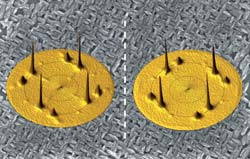Materials Sciences
Materials management deals with the research, development, manufacturing and processing of raw and industrial materials. Key aspects here are biological and medical issues, which play an increasingly important role in this field.
innovations-report offers in-depth articles related to the development and application of materials and the structure and properties of new materials.

New Surface Can Find Different Twists on a Molecular Theme
Researchers have created a new process to produce materials that can sift through similar, molecular brethren and latch onto chemicals that differ from each other in only their mirrored images. If it proves effective in large-scale experiments, the stable, relatively simple catalyst could impact the $100 billion pharmaceutical industry by helping sort biologically potent chemicals from related, yet less useful or even toxic, compatriots. Jay Switzer and colleagues at the University

University of Toronto professor turns hemp into auto parts
If Mohini Sain has his way, cars of the future may be fitted with tough, durable and completely biodegradable bumpers made of hemp.
Sain, a professor in the University of Toronto’s Faculty of Forestry and Department of Chemical Engineering and Applied Chemistry, creates biocomposites from processed plant fibres. His latest research, published in the August issue of Materials Research Innovations and the July issue of Macromolecular Materials and Engineering, describes a way to create a

New material lubricates itself
A highly durable and moreover self-lubricating material has seen the light of day at a thin film laboratory at Linköping University.
It is an alloy of boron suboxide and yttrium, BOY, and was grown by the physicist Denis Music. The discovery is put forward in his doctoral dissertation.
The element boron and its compounds have many interesting properties, but they have been difficult to exploit industrially because production involves extreme process conditions. To produce a crystal

Ceramics reinforced with nanotubes
A ceramic material reinforced with carbon nanotubes has been made by materials scientists at UC Davis. The new material is far tougher than conventional ceramics, conducts electricity and can both conduct heat and act as a thermal barrier, depending on the orientation of the nanotubes.
Ceramic materials are very hard and resistant to heat and chemical attack, making them useful for applications such as coating turbine blades, said Amiya Mukherjee, professor of chemical engineering and mater

Ductile intermetallic compounds discovered
Ames Laboratory researchers identify non-brittle intermetallics
To material scientists the phrase “ductile intermetallic compounds” has long been considered an oxymoron. Although these compounds possess chemical, physical, electrical, magnetic, and mechanical properties that are often superior to ordinary metals, their potential has gone untapped because they are typically quite brittle at room temperature. Until now.
Researchers at the U.S. Department of Energy’s Ames

Synthesis of cage-like silica structure easier and cheaper
A tailored, cage-like silica structure, developed by Penn State researchers, is easier and less expensive to make than previous materials and is tunable in size.
“Previous attempts at synthesizing materials like PSU-1 involved specially designed templates making the process expensive,” says Dr. Sridhar Komarneni, professor of clay mineralogy. “The processes also require stringent conditions for the synthesis to work.” Komarneni, working with Dr. Bharat L. Newalkar, postdoctoral fellow in Pe